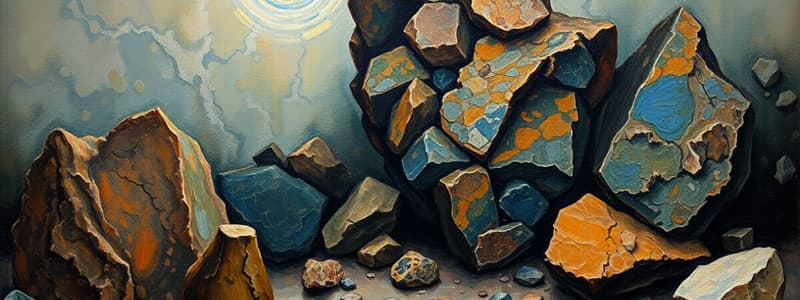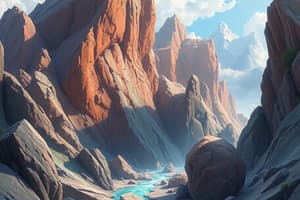Podcast
Questions and Answers
A mineral displays a metallic luster and high electrical conductivity. Which of the following elements is most likely a significant component?
A mineral displays a metallic luster and high electrical conductivity. Which of the following elements is most likely a significant component?
- Iron (correct)
- Silicon
- Calcium
- Sulfur
During the formation of a metamorphic rock, what is the most significant factor influencing the alignment of platy minerals such as mica, leading to foliation?
During the formation of a metamorphic rock, what is the most significant factor influencing the alignment of platy minerals such as mica, leading to foliation?
- The rate of cooling of the parent rock.
- The intensity of chemical weathering before metamorphism.
- The direction and magnitude of applied stress. (correct)
- The presence of water during the metamorphic process.
Which of the following scenarios would most likely result in the formation of a coarse-grained igneous rock?
Which of the following scenarios would most likely result in the formation of a coarse-grained igneous rock?
- Rapid cooling of lava on Earth's surface.
- Extensive chemical weathering of existing rocks.
- High-pressure metamorphism of sedimentary rocks.
- Slow cooling of magma deep within Earth's crust. (correct)
In a region characterized by intense chemical weathering, which mineral would you expect to be least susceptible to alteration?
In a region characterized by intense chemical weathering, which mineral would you expect to be least susceptible to alteration?
A large-scale slump is observed after a period of heavy rainfall on a steep, vegetated slope. What is the primary mechanism that most likely triggered this mass wasting event?
A large-scale slump is observed after a period of heavy rainfall on a steep, vegetated slope. What is the primary mechanism that most likely triggered this mass wasting event?
During regional metamorphism, what combination of factors is most critical in determining the new mineral assemblages that form within a rock?
During regional metamorphism, what combination of factors is most critical in determining the new mineral assemblages that form within a rock?
In a subduction zone, melting of the mantle wedge is often induced by the addition of volatiles. Which of the following is the most significant volatile component contributing to this process?
In a subduction zone, melting of the mantle wedge is often induced by the addition of volatiles. Which of the following is the most significant volatile component contributing to this process?
What is the primary difference between magma and lava regarding their role in forming igneous rocks?
What is the primary difference between magma and lava regarding their role in forming igneous rocks?
Which of the following properties is least reliable when identifying a mineral and why?
Which of the following properties is least reliable when identifying a mineral and why?
Considering the rock cycle, which process directly links metamorphic rocks back to the formation of igneous rocks?
Considering the rock cycle, which process directly links metamorphic rocks back to the formation of igneous rocks?
A geologist discovers a rock composed primarily of cemented shells and marine organisms. What type of sedimentary rock is this most likely?
A geologist discovers a rock composed primarily of cemented shells and marine organisms. What type of sedimentary rock is this most likely?
What role does water play in both chemical and physical weathering processes?
What role does water play in both chemical and physical weathering processes?
Why are extrusive igneous rocks typically fine-grained, while intrusive igneous rocks are coarse-grained?
Why are extrusive igneous rocks typically fine-grained, while intrusive igneous rocks are coarse-grained?
Which characteristic primarily differentiates a debris flow from a mudflow type of mass wasting?
Which characteristic primarily differentiates a debris flow from a mudflow type of mass wasting?
Considering the process of metamorphism, what is the most important agent in contact metamorphism?
Considering the process of metamorphism, what is the most important agent in contact metamorphism?
How does the Bowen's Reaction Series explain the formation of different igneous rocks?
How does the Bowen's Reaction Series explain the formation of different igneous rocks?
What is the significance of understanding earth materials for civil engineering projects?
What is the significance of understanding earth materials for civil engineering projects?
A geologist examining a rock sample finds that it bends elastically under pressure but returns to its original shape when the pressure is released. Which mineral property is the geologist observing?
A geologist examining a rock sample finds that it bends elastically under pressure but returns to its original shape when the pressure is released. Which mineral property is the geologist observing?
How does the process of lithification contribute to the formation of sedimentary rocks?
How does the process of lithification contribute to the formation of sedimentary rocks?
In what way does the process of erosion influence the rock cycle?
In what way does the process of erosion influence the rock cycle?
Why is understanding the streak of a mineral more useful than observing its color during identification?
Why is understanding the streak of a mineral more useful than observing its color during identification?
How do endogenous processes, such as volcanism and magmatism, shape Earth's surface?
How do endogenous processes, such as volcanism and magmatism, shape Earth's surface?
Which of the following scenarios best illustrates the process of physical weathering?
Which of the following scenarios best illustrates the process of physical weathering?
During the formation of a sedimentary rock, what is the primary role of cementation?
During the formation of a sedimentary rock, what is the primary role of cementation?
What is the significance of crystalline structure in defining a mineral?
What is the significance of crystalline structure in defining a mineral?
How do metamorphic rocks provide evidence of the Earth's dynamic internal processes?
How do metamorphic rocks provide evidence of the Earth's dynamic internal processes?
What is the role of magma in the formation of volcanic landforms such as shield volcanoes and stratovolcanoes?
What is the role of magma in the formation of volcanic landforms such as shield volcanoes and stratovolcanoes?
How does understanding the Mohs hardness scale contribute to mineral identification?
How does understanding the Mohs hardness scale contribute to mineral identification?
Why is it important to study earth materials in the context of environmental science?
Why is it important to study earth materials in the context of environmental science?
What conditions during metamorphism are most likely to produce a foliated metamorphic rock?
What conditions during metamorphism are most likely to produce a foliated metamorphic rock?
How does the chemical weathering process called oxidation affect earth materials, particularly rocks?
How does the chemical weathering process called oxidation affect earth materials, particularly rocks?
What can the presence of certain index minerals in a metamorphic rock indicate about its formation environment?
What can the presence of certain index minerals in a metamorphic rock indicate about its formation environment?
Why is understanding the processes of sedimentation essential for interpreting Earth's history?
Why is understanding the processes of sedimentation essential for interpreting Earth's history?
How does the concept of specific gravity aid in the identification of minerals?
How does the concept of specific gravity aid in the identification of minerals?
What is the primary difference between physical and chemical weathering in terms of their effects on earth materials?
What is the primary difference between physical and chemical weathering in terms of their effects on earth materials?
How does the process of metamorphism contribute to the formation of valuable ore deposits?
How does the process of metamorphism contribute to the formation of valuable ore deposits?
What role do fluids play in the process of metamorphism?
What role do fluids play in the process of metamorphism?
How does the presence of different minerals in a rock influence its resistance to weathering?
How does the presence of different minerals in a rock influence its resistance to weathering?
How does the concept of plate tectonics relate to the formation of different types of rocks?
How does the concept of plate tectonics relate to the formation of different types of rocks?
Flashcards
What are minerals?
What are minerals?
Naturally occurring inorganic solids with a crystalline structure and definite composition.
What is a streak?
What is a streak?
The color of a mineral in powdered form, determined by rubbing it on a streak plate.
What is Hardness?
What is Hardness?
Resistance to scratching, measured on a scale of 1-10.
What are Cleavage and Fracture?
What are Cleavage and Fracture?
Signup and view all the flashcards
What is Luster?
What is Luster?
Signup and view all the flashcards
What are Igneous Rocks?
What are Igneous Rocks?
Signup and view all the flashcards
What are Sedimentary Rocks?
What are Sedimentary Rocks?
Signup and view all the flashcards
What are Metamorphic Rocks?
What are Metamorphic Rocks?
Signup and view all the flashcards
What is weathering?
What is weathering?
Signup and view all the flashcards
What is Physical Weathering?
What is Physical Weathering?
Signup and view all the flashcards
What is Chemical Weathering?
What is Chemical Weathering?
Signup and view all the flashcards
What is Erosion?
What is Erosion?
Signup and view all the flashcards
What is Mass Wasting?
What is Mass Wasting?
Signup and view all the flashcards
What is Sedimentation?
What is Sedimentation?
Signup and view all the flashcards
What is Magma?
What is Magma?
Signup and view all the flashcards
What is Volcanism?
What is Volcanism?
Signup and view all the flashcards
What is Metamorphism?
What is Metamorphism?
Signup and view all the flashcards
What are Earth materials?
What are Earth materials?
Signup and view all the flashcards
What is Specific Gravity?
What is Specific Gravity?
Signup and view all the flashcards
Study Notes
- Earth materials encompass minerals, rocks, soil, water, air, and organic matter.
- These materials support life, land structure, and human civilization.
Minerals
- Minerals are naturally occurring, inorganic solids.
- They possess a crystalline structure and a definite chemical composition.
- Examples of minerals include salt, sulfur, quartz, and graphite.
Physical Properties of Minerals
- Color is an easily observable but unreliable property for mineral identification.
- Streak is the color of a mineral in powdered form and is determined by rubbing it on a streak plate.
- Hardness is measured using the Mohs scale, ranging from 1 (talc) to 10 (diamond).
- Cleavage refers to breaks along smooth planes, while fracture refers to irregular breakage patterns.
- Crystalline Structure refers to the ordered arrangement of atoms in a repeating pattern.
- Transparency (Diaphaneity) describes how light passes through a mineral, categorized as transparent, translucent, or opaque.
- Magnetism is when certain minerals attract or repel magnets.
- Tenacity measures a mineral's resistance to breaking, bending, or deforming.
- Luster describes how light reflects off a mineral's surface, such as metallic, dull, or glassy.
- Odor is when certain minerals emit a distinct smell when rubbed, heated, or exposed to air.
- Specific Gravity is the density of a mineral compared to water.
Types of Rocks
- Rocks are classified into igneous, sedimentary, and metamorphic types.
Igneous Rocks
- Igneous rocks form from the cooling and solidification of magma or lava through crystallization.
- Examples include granite and basalt.
Sedimentary Rocks
- Sedimentary rocks form from the deposition and cementation of sediments (plants, dead animals and other minerals), and lithification.
- Most sedimentary rocks are found in bodies of water like oceans, seas and rivers.
- Examples include sandstone and limestone.
Metamorphic Rocks
- Metamorphic rocks form when igneous or sedimentary rocks undergo high pressure and temperature.
- This results in changes to the structure and mineral composition.
- Examples include gneiss and migmatite.
- Metamorphism involves heat, pressure, and recrystallization.
Rock Cycle
- The rock cycle describes the transformation of rocks from one type to another.
- Igneous rocks undergo weathering and erosion to form sedimentary rocks.
- Sedimentary rocks subjected to heat and pressure become metamorphic rocks.
- Metamorphic rocks melt into magma, which cools to form igneous rocks.
Types of Exogenous Processes
- Exogenous processes occur on the Earth's surface.
Weathering
- Weathering is the disintegration of rocks, soil, and minerals.
- It occurs due to contact with Earth's systems.
- Physical weathering breaks down rocks through mechanical forces like temperature changes.
- Chemical weathering involves chemical reactions that alter minerals, such as oxidation and hydrolysis.
Erosion
- Erosion is the wearing away of the Earth's surface by natural forces (wind, water, ice).
- Rainfall, surface runoff, and human activities like deforestation and mining cause erosion.
Mass Wasting
- Mass wasting is the movement of large masses of materials down slopes due to gravity.
- Debris flow involves rapid movement of sediments down a slope.
- Mudflow is a combination of soil and water flowing down a slope.
- Slump is a slow movement of soil along a curved surface.
Sedimentation
- Sedimentation is the accumulation of materials (soil, rocks) that settle on the ground.
Endogenous Processes
- Endogenous processes occur within the Earth and are driven by thermal energy from the mantle.
- These processes shape the Earth's surface leading to earthquakes and volcanic activity.
Magmatism
- Magmatism is the original material that forms igneous rocks, originating beneath the Earth's surface at extreme heat.
- Magma rises through the mantle and can lead to volcanic eruptions when it escapes through cracks in the Earth's crust.
Volcanism (or Plutonism)
- Volcanism occurs when magma escapes from the mantle and travels to the surface, forming volcanic materials.
- Magma erupts and becomes lava, which solidifies to form new volcanic rock.
Metamorphism
- Metamorphism alters the materials making up rocks due to changes in pressure and temperature.
Studying That Suits You
Use AI to generate personalized quizzes and flashcards to suit your learning preferences.





